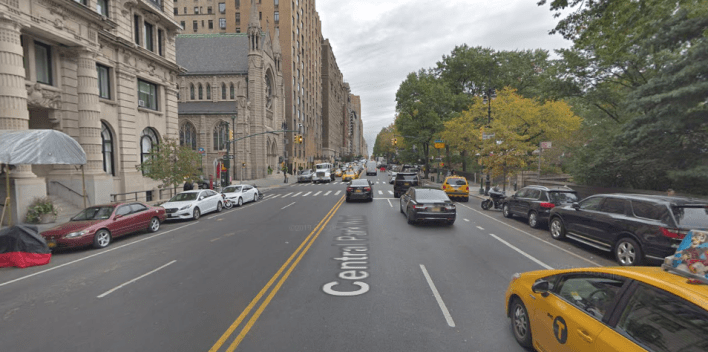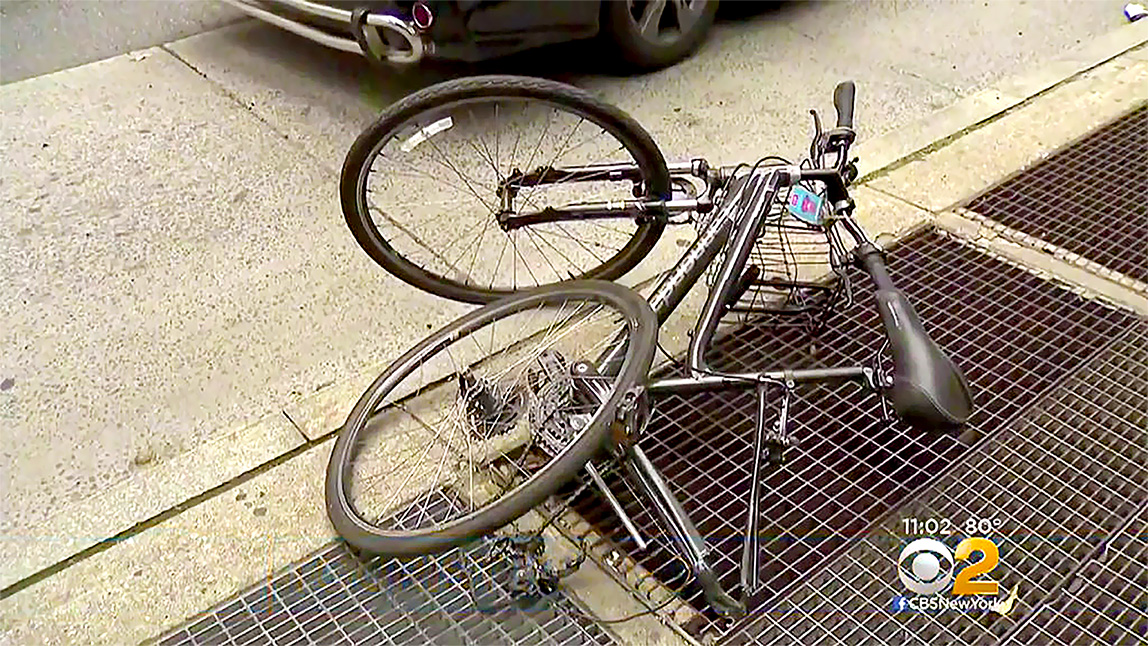Insert frown-face emoji here.
The Department of Transportation finally revealed late on Friday its long-awaited plans for a protected bike lane on Central Park West from 59th to 110th streets — but the agency's tweet that the cycle track would consist only of a one-way northbound lane was roundly and immediately slammed on bike Twitter.
"This needs to be a 2 way bike lane just like Prospect Park," said Melodie Bryant, referring to the two-way lane alongside Brooklyn's greenspace, which like Central Park, was designed by Olmsted and Vaux. "No reason not to do this."
"There’s a chance to do something transformative here and make a very wide-two way bike lane," added activist Doug Gordon. "Why make this one-way?"

The reason, others speculated, is parking. Protected bike lanes on both sides of Central Park West would likely require some reuse of public space that some residents and visitors believe exists solely so they can store their private cars. Several regular cyclists pointed out that Central Park West — which carries two lanes of travel in both directions, plus parking and bus stops on each side — is wide enough to handle more than just a single northbound protected bike lane. DOT often reconfigures four-lane roads into two-lane roads with turning bays to avoid backups created when drivers want to turn left.
The widespread call for a protected bike lane on Central Park West began in earnest after Australian tourist Madison Lyden was killed last year on the roadway by a drunken truck driver after she was forced into traffic when a cabbie cut her off and pulled into the painted bike lane. It was widely assumed that the agency would present a two-way protected lane to Community Board 7 on June 11 — but days before the meeting, the agency revealed its one-way, one-side proposal.
At least one member of the board put the proposal in a positive context.
"[A one-way lane] is something less than what many people wanted, but much more than we currently have," said CB7 member Howard Yaruss.
On Tuesday, 6/11 at 7PM DOT will present a proposal to install northbound protected #bikenyc lane along Central Park West from 59th to 110th Sts to @CB7Manhattan Transportation Committee. pic.twitter.com/iK4eThRAD1
— NYC DOT (@NYC_DOT) June 7, 2019
But for now at least, Yaruss seemed to be in the minority of people able to see a half-full glass.
"You guys love to disappoint!" tweeted Macartney Morris. "But on the other hand: those who drive and park their cars will be overjoyed! Nice work, team."
There is no information about the Central Park West plan on the DOT website, so it is unclear if the design calls for anything beyond a standard protected lane. Central Park is one of the city's pre-eminent tourist attractions, drawing large crowds of out-of-towners, who are often unaccustomed to cyclists. Agency spokespeople did not return a late Saturday email for comment.
At the June 11 hearing, DOT officials will likely point out that there is a southbound protected lane on Columbus Avenue, one block to the west of Central Park. Plus, the roadway inside the park — which was was made off-limits to cars last year — goes in a southbound direction, meaning that cyclists can get from points north to Midtown along Columbus or within the park.
Can't believe after all this time they're coming to us with a one way bike lane? I thought lives were at stake..
— @bikeloveny@post. (@bikeloveny) June 7, 2019
Still, the the one-way/one-lane plan will likely disappointed local Council Member Helen Rosenthal, who has called for a two-way protected lane along Central Park West's eastern side — just as Prospect Park has a two-way lane along its edge.
Community Board 7 has also called for more protection — and redoubled that call after Lyden's death — but, as Streetsblog reported last year, "DOT has balked at previous requests from the board for such an upgrade, no doubt knowing that a small, but vocal, minority of car owners would object if any on-street car storage is removed."
The board was motivated by statistics showing that between 2012 and Lyden's death on Aug. 10, 2018, over 430 people were injured on Central Park West, including 113 cyclists, according to city data compiled by committee member Richard Robbins. Since August 2018, there have been 386 crashes along Central Park West, resulting in injuries to 26 cyclists, 14 pedestrians and 34 motorists, with Lyden as the lone fatality.
Most of CPW is 62' wide with 2 car lanes in each direction. Converting it to 1 through lane each way plus turn lanes would allow both a two-way protected bike lane and planted medians mid-block. https://t.co/4oompnPV6ihttps://t.co/pMTbcfGZ3yhttps://t.co/NLyrYtXl0P pic.twitter.com/dcy6mZha4f
— BrandonWC (@BrandonWC) August 14, 2018






